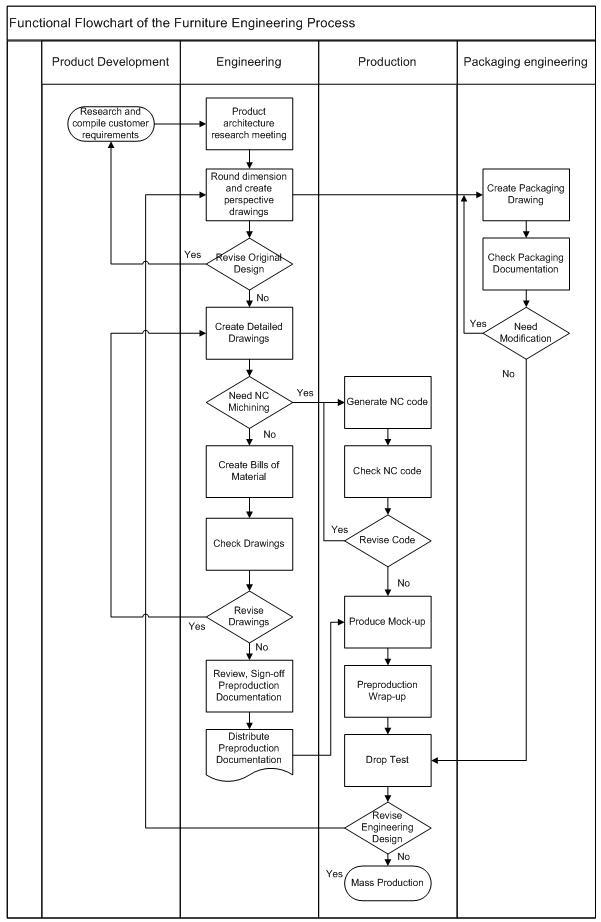Andersen and Fagerhaug (2001) defines a process as “a logic series of related transactions that converts input to results or output.” The engineering process is an important component of a business process since it is (Ericsson 1993):
A chain of logical connected, repetitive activities that
utilizes the enterprise’s resources to
refine an object (physical or mental)
for the purpose of achieving specified and measurable results/products for
internal or external customers

Our previous had identified the product family within a case study household furniture manufacturer, next we could further define different processes of engineering for making the family of products. Figure 1 shows a typical furniture engineering process by using functional flow chart.
Further, based on our initial study, we specifically identify 15 major engineering processes for the sofa products. Each process is interpreted in Table 1.
Table 1. Fifteen engineering major processes
| ID | Process | Interpretation |
| 1 | Research Product Architecture | Generally, this process is fulfilled by a product architecture discussion meeting. The attendees include associates from three departments which are product development, engineering, and production. The goal of this meeting is to streamline each product architecture in the context of customer requirements, engineering feasibility, and production manufacturability. |
| 2 | Create drawings and bills of material (BOM) | Drawings include perspective drawings, assembly drawings, part drawings, cutting tool drawings for fabrication. BOM includes both bills of material and bills of hardware. |
| 3 | Create fabric cutting drawings | The previous step completes the drawings for solid wood and wood-based components. Since most of the upholstery products contain fabric material, the fabric cutting drawing is generated to telling the production associates how to cut the fabric. |
| 4 | Apply new material SKU# | Since new product inevitably needs to use new material, so engineers need to apply new SKU# for each type of material to facilitate the procurement process |
| 5 | Create law tag | This is a mandatory tag shows that the product attributes are compliance with the local law for distributing and selling in the destination market |
| 6 | Fill out material purchasing form | As long as the SKU# is approved, engineer can start to fill out the purchasing form to order certain materials and attach essential drawings and specification to the use of suppliers |
| 7 | Create sofa specifications | The specifications include both design specification for engineering details and manufacturing specification for fabrication details |
| 8 | Create 2.5 axis CNC programs | The programs include all the precision machining by the CNC machine such as certain component fabrication templates, part routing programs, and plywood dies for the thermoforming process |
| 9 | Check/sign-off/distribute preproduction documents | After all the above processes, a preproduction document is established which contains all the essential drawings, bills of material, instruction, specification for fabricating a product or product family. Next, the engineering supervisor will check the document, then the document will sign-off by the engineering manager and distribute to the manufacturing plant. |
| 10 | Follow up preproduction mock-up process | After releasing the preproduction document, engineers also need to coordinate with production associate on fabricating the mock-up and collect feedback on fabrication difficulties in the mock-up process |
| 11 | Compile mass production document | According to the fabrication feedback in the mock-up process, engineers could start improving the engineering design and making adjustments in the mass production document |
| 12 | Check/sign-off/distribute mass production documents | Engineering supervisor and manager do the same process to check, sign-off, and distribute mass production documents |
| 13 | Create fabric manufacturing specification | This process paralleled with the process of generating production documents. The document not only include detail design specifications, but also contains detailed information on fabric material and what specific area of a certain product will apply this material |
| 14 | Create packaging document | This process happens after the process of generating production documents. The packaging document include all the drawings, BOM, and specification for packaging a furniture product |
| 15 | Create 5-axis CNC program | This process parallel with the process of generating production documents. It usually deals with 3D-shaped components that are difficult to generate in the 2.5-axis CNC machine. |
The processes in Table 1 that we identified include both primary engineering processes and secondary engineering processes. The primary engineering processes refer to all types of value-added engineering activities performed by the majority of product engineers for designing on-demand product architecture (1-12). The secondary engineering processes refer to the required value-added engineering activities performed by the individual product engineer mainly to facilitate production process (13-15).
Identifying each process is the basis for further analysis on process efficiency. Based on the engineering processes identified above, next the research will focus on identifying essential process metrics such as cycle time and queue time, and finally the value-added time of the process could be identified
References:
- Andersen, B., and T. Fagerhaug. 2001. Advantages and disadvantages of using predefined process models. Proceedings fra Strategic Manufacturing, IFIP WG5 7.
- Ericsson Quality Institute (1993): Business Process Management, Gothenburg, Sweden.
